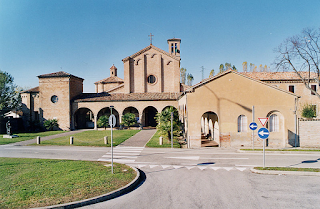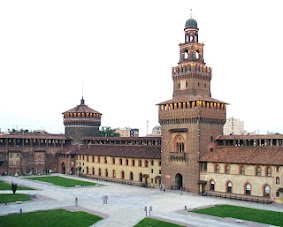Mercenary captain who founded Sforza dynasty
.jpg) |
| Muzio Attendolo Sforza became a soldier at the age of just 13 |
A career soldier who made his fortune as a mercenary captain - a condottiero - Muzio was a key figure in many of the wars between rival states across Northern Italy in the late 14th and early 15th century, eventually losing his life on the battlefield.
He acquired the name Sforza initially as a nickname but it was eventually adopted as a family name. His illegitimate son, Francesco, one of Muzio’s 16 known children, became the first Sforza Duke of Milan through his marriage to Bianca Maria Visconti, whose father, the last Visconti Duke of Milan, died without a male heir.
Some accounts have it that the Sforza family grew from peasant origins. Muzio, in fact, though from a rural background, was born into family with noble roots, who were relatively well off.
Given the name of Giacomo or Jacopo at birth, he was called Muzio because it had been the name by which his paternal grandfather, Giacomuzzo, was commonly known.
According to legend, the 13-year-old Muzio was hoeing a field on the family estate when a company of mercenaries led by the condottiero Boldrino da Panicale passed nearby, seeking recruits. Muzio, tempted to join them in search of a more exciting life, is said to have thrown his hoe at a nearby tree, deciding that if the blade stuck in the tree then fate would have determined that it was right for him to join up. It did stick, upon which he stole one of his father’s horses and headed for a new life.
He stayed with Da Panicale for four years, initially as a page and guard, then an infantryman. His father forgave him for stealing a horse and in 1386 made him a gift of four horses, which enabled Muzio, along with his brothers, Bosio, Francesco and Bartolo, to join the company of Alberico da Barbiano, the protege of the English mercenary John Hawkwood, which fought under the flag of St George.
.jpg) |
| Sforza fought for numerous warring states in the Italy of the Middle Ages |
In the manner of condottieri, he fought with and against different leaders at different times, including Gian Galeazzo Visconti of Milan and the Medici of Florence. In the Battle of Casalecchio in 1402, leading the armies of Bologna and Florence, he came up against a Milanese army led by Da Barbiano and was defeated. In 1409, he fought for Niccolò III d'Este’s Ferrara against Ottobuono de' Terzi of Reggio-Emilia.
Later he entered the service of the Kingdom of Naples, mainly fighting against the forces of Florence and the Papal States. It was while he was in the service of Queen Giovanna that he died, in 1423.
Sent to aid the city of L’Aquila in their uprising against Braccio da Montone, he went to the aid of a page, who was in difficulties during the crossing of the Pescara river, near the coastal city of the same name, but himself encountered a strong current. He was swept away and drowned.
Muzio’s 16 children were borne by three wives and two mistresses. Francesco was the first of eight children he fathered with his mistress, Lucia Terzani da Marsciano.
Born in 1401, he fought alongside his father in the War of L’Aquila, participating in Braccio da Montone's eventual defeat in that campaign. Subsequently, he fought for the army of Naples and then for Pope Martin V and the Duke of Milan, Filippo Maria Visconti. After leading the Milanese forces against Venice, the duke’s daughter was betrothed to him. He became Duke of Milan himself in February 1450, three years after Filippo Maria Visconti died.
He controlled the Duchy for 16 years until his death. Five other Sforza Dukes of Milan followed, the last of whom, Francesco II, died childless in 1535, upon which the Duchy reverted to the Holy Roman Emperor, Charles V.
 |
| The church of San Francesco in Cotignola, which was turned into the Sforza family tomb in 1400 |
The town of Cotignola in Emilia-Romagna, where Muzio Attendolo Sforza was born, is situated about 25km (16 miles) from Ravenna and 13km (8 miles) north of Faenza. It had the misfortune to find itself on the German World War II defensive line along the Senio river, established in 1944 an attempt to repel the Allied advance following the invasion of Sicily. As a result, it was largely destroyed by bombing. After the war, the town did its best to restore some of its more important landmarks, which include the tower belonging to the English mercenary soldier, John Hawkwood, and the Palazzo Sforza, the historical residence of the Sforza noble family, which was rebuilt in 1961. Some original features, such as the coat of arms of the House of Sforza and the portico columns, were preserved. Just outside the centre of the town is the church of San Francesco, with the oratory of Santa Maria degli Angeli, which was turned into the tomb of the Sforza nobles in 1400.
Travel tip:The inner courtyard of the Castello Sforzesco
and the imposing Torre del Filarete
Among the main sights in Milan is the impressive Sforza castle, Castello Sforzesco, which Francesco Sforza had built on the site of the Castello di Porta Giovia, which had been the main residence in the city of the Visconti family. Galeazzo II Visconti was responsible for the original, a square-plan castle with 200m-long sides, four towers at the corners and walls up to seven metres (23 ft) thick. Francesco Sforza hired the sculptor and architect Filarete to design and decorate the central tower, which is still known as the Torre del Filarete. Renovated and enlarged a number of times in subsequent centuries, it became one of the largest citadels in Europe and now houses several museums and art collections. After Ludovico Sforza became Duke of Milan in 1494, he commissioned Leonardo da Vinci to fresco several rooms. For more information visit www.milanocastello.it
Also on this day:
1606: The painter Caravaggio murdered Ranuccio Tomassoni in Rome, after a brawl
1692: The birth of composer Geminiano Giacomelli
1839: The birth of author and journalist Luigi Capuana
1987: The birth of cricketer Leandro Jayarajah

_Profile_of_a_Young_Lady_(Lucrezia_Crivelli).jpg)

.jpg)

.jpg)

.jpg)







.jpg)








